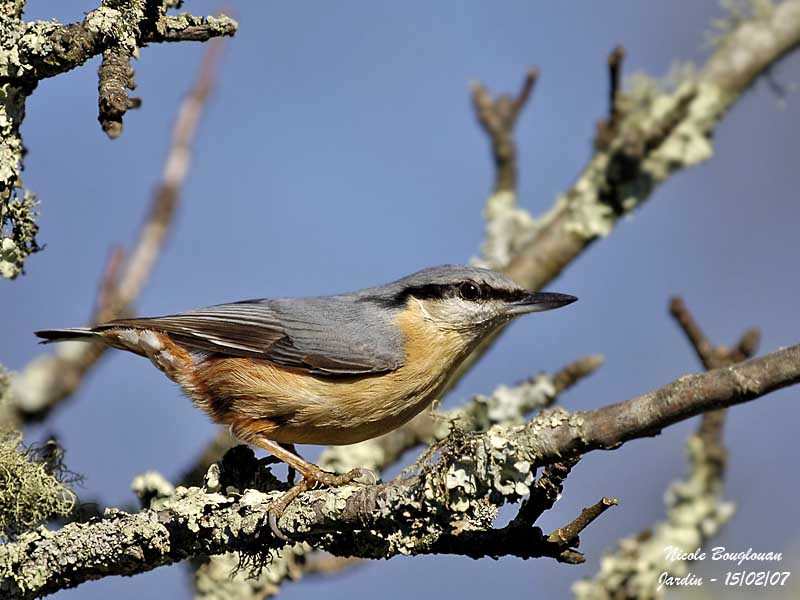Eurasian Nuthatch
Nuthatch ( Sitta europaea)
The Nuthatch ( Sitta europaea ) is a species of bird in the family of Kleiber.
Name
The name refers to the fact that the nuthatch as the bonds the entrance of nests of other birds, woodpeckers, with clay in order to use it yourself. The term " nuthatch " comes from the Middle High German and designated craftsmen, created the clay walls. In order to protect the cave from access by martens or crows " substantiate " that Kleiber the entrance to their nests with a mixture of mud and saliva so far that they just fit through. The nuthatch is also called " nuthatch " because his way of life and its appearance on both birds - woodpeckers and chickadees - recalls.
Features
The nuthatch reaches a body length of 12 to 14.5 centimeters. The body is stocky with a large head, very short neck and a short tail. The beak is long, pointed and gray colored. The top of the plumage is blue-gray and the bottom depending on the subspecies white to ocher or rust colored. In the increasingly red-brown upper tail-coverts are large, white spots. The Nuthatch has a black eye stripe. The cheeks and throat are white. The iris is black and the legs are orange-yellow.
Voice
The nuthatch is very ruffreudig and loud, usually the first to notice by means of the voice. He has an extensive repertoire. In search of food he gets a sharp and pointed, such as " zit " sounding contact call. When excited, he calls the strong, loud and about how " twett " sounding warning call. This is often called in quick, short bursts with short breaks between several consequences.
The song consists of several loud verses of different types that are carried forward from an elevated seat vantage point. Most are slow trains of the same whistle that can or something to - descend, such as " wuih wuih wuih wuih ..." or " wiiü wiiü wiiü wiiü ... ". Some variants of verses can also fast, clear and warbling, such as " wiwiwiwiwiwi ...", or slow and rhythmic ranked as " djüdjüDJÜ djüdjüDJÜ " sound.
System
The nuthatch is in Europe into three subspecies:
- S. europaea e - the nominate form occurs in Fennoscandia. The sides of the trunk are rust beige, the breast and belly are whitish center, sometimes with whitish forehead.
- P e caesia - occurs in Central Europe. The underside is beige, males have intense red-brown flanks.
- S. asiatica e - occurs in eastern Russia and in Siberia, but also occurs occasionally in Finland. The underside is white, the top light blue-gray. On the forehead and above the eye-streak is something white. The subspecies is smaller, her mouth thin.
Behavior and reproductive
The nuthatch is a sedentary bird and so site- faithful, that ringed birds are again found almost exclusively in the vicinity of their Beringungsortes. Recoveries as a bird in 163 km distance are an exception.
The nuthatch is nimble, agile and climbs abruptly and sent to trunks and branches along. In contrast to the tree-creeper and woodpeckers he can climb upside down. He puts one foot forward and clings to the other on the bark of the tree. So he "runs" on the tree trunk, while woodpeckers and tree creepers are supported with the tail and set before both feet simultaneously.
Kleiber lay nests ( tree cavities, nest boxes or old Spechtbauten ) made with pieces of bark, hair, grass and feathers. You put five to nine milky white eggs with rust-red spots that they incubate in March to May 14 to 18 days. The nestlings are fed for about 24 days.
Distribution and population
The Eurasian Nuthatch comes in Europe, Northwest Africa and Asia ( with the exception of South and Southeast Asia ), ie from Britain to Japan before, the continental European subspecies inhabits larger trees in mixed deciduous forests, parks and gardens. In Germany, about eight percent of the global portfolio are located, the total population is estimated by the IUCN to about 10 million animals and is considered " not at risk '.
Food
The diet consists mainly of insects, insect eggs and larvae. In autumn, seeds, berries and nuts are added. Larger prey caught the nuthatch in cortical column, hangs upside down over it and carves with the powerful beak bite-sized morsels from. He also caught bigger nuts and acorns into suitable tree columns to them with his powerful beak hammers to crack. He puts stocks of food.
Bird of the Year 2006
Because of its uniqueness and its close ties to forests with old trees, the Wildlife Protection Society Germany eV and BirdLife Austria announced on 7 October 2005, the Nuthatch at the Bird of the Year 2006 in Germany and Austria. This is thus a plea for the protection of oak and beech forests.










